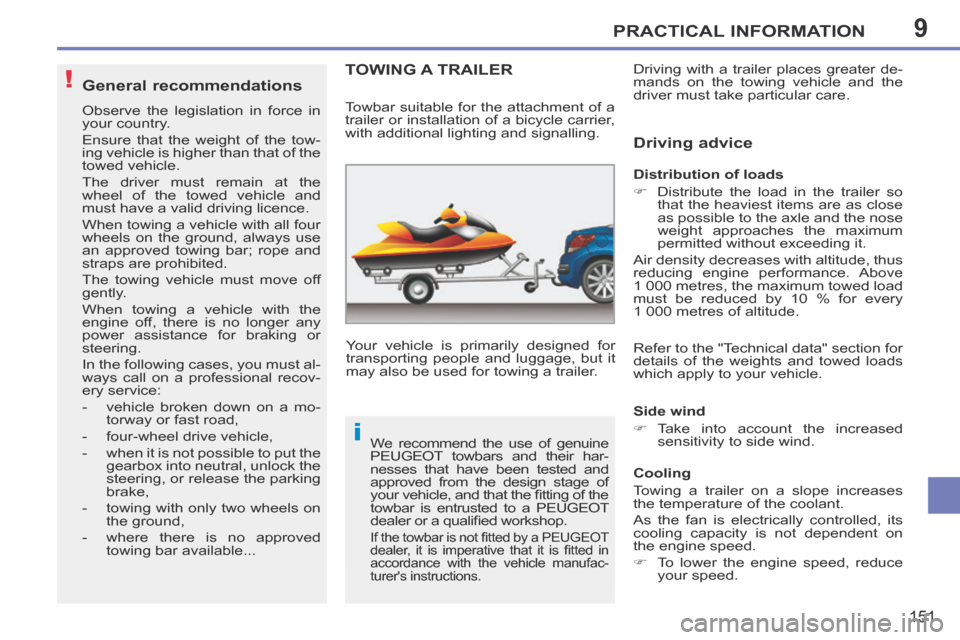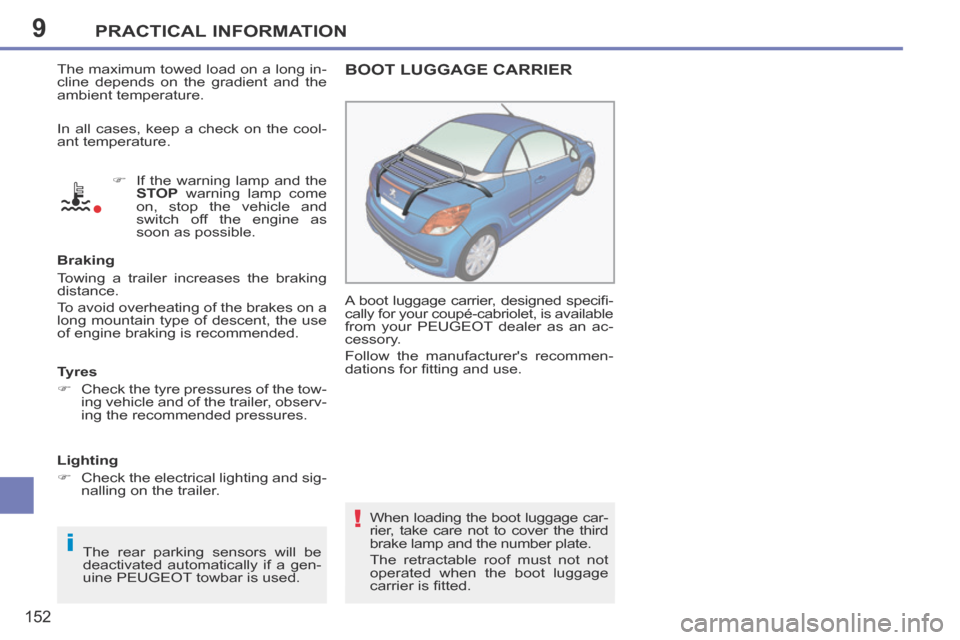engine Peugeot 207 CC 2014 Workshop Manual
[x] Cancel search | Manufacturer: PEUGEOT, Model Year: 2014, Model line: 207 CC, Model: Peugeot 207 CC 2014Pages: 232, PDF Size: 11.11 MB
Page 150 of 232

9
!
i
PRACTICAL INFORMATION
148
207CC_EN_CHAP09_INFO PRATIQUES_ED01-2014
Do not charge the batteries without
disconnecting the terminals fi rst.
Do not disconnect the terminals
while the engine is running.
The batteries contain harmful sub-
stances such as sulphuric acid and
lead. They must be disposed of in
accordance with regulations and
must not, in any circumstances, be
discarded with household waste.
Take used remote control batteries
and vehicle batteries to a special
collection point.
Charging the battery using a battery charger
Disconnect the battery from the ve- hicle.
Follow the instructions for use pro- vided by the manufacturer of the
charger.
Reconnect starting with the nega- tive terminal (-).
Check that the terminals and connec- tors are clean. If they are covered with
sulphate (whitish or greenish deposit),
remove them and clean them.
It is advisable to disconnect the
battery if the vehicle is to be left un-
used for more than one month. Before disconnecting the
battery
Wait 2 minutes after switching off
the ignition before disconnecting
the battery.
Close the windows and the doors
before disconnecting the battery.
Following reconnection of the
battery
Following reconnection of the bat-
tery, switch on the ignition and wait
1 minute before starting to permit
initialisation of the electronic sys-
tems. However, if slight diffi culties
are encountered following this op-
eration, contact a PEUGEOT deal-
er or a qualifi ed workshop.
Referring to the corresponding sec-
tion, you must yourself reinitialise:
- the remote control key,
- the one-touch electric windows,
- the GPS satellite navigation
system (depending on version).
Disconnecting the (+) cable
Reconnecting the (+) cable
Position the open clamp
E of the
cable on the positive post (+) of the
battery.
Press vertically on the clamp E to
position it correctly on the battery.
Lock the clamp by spreading the po- sitioning lug and then lowering the
tab D .
Do not apply excessive force on the
tab as locking will not be possible if the
clamp is not positioned correctly; start
the procedure again.
Raise the locking tab D fully to re-
lease the cable terminal clamp E .
Page 151 of 232

9
!
i
PRACTICAL INFORMATION
149
207CC_EN_CHAP09_INFO PRATIQUES_ED01-2014
A fl at battery prevents the engine
from starting (refer to the corre-
sponding paragraph).
If a roof operation is in progress,
it will be completed, but no further
operation is possible.
ENERGY ECONOMY MODE
System which manages the duration of
use of certain functions to conserve a
suffi cient level of charge in the battery.
After the engine has stopped, you can
still use functions such as the audio
equipment, windscreen wipers, dipped
beam headlamps, courtesy lamp, etc.
for a maximum combined duration of
thirty minutes.
Exiting economy mode
These functions are reactivated auto-
matically next time the vehicle is driven.
In order to resume the use of these
functions immediately, start the
engine and let it run for a few minutes.
The time available to you will then be
double the duration for which the engine
is left running. However, this period will al-
ways be between fi ve and thirty minutes.
Switching to economy mode
Once the thirty minutes are over, a
message appears on the multifunction
screen indicating that the vehicle has
switched to economy mode and the ac-
tive functions are put on standby.
CHANGING A WIPER BLADE
Procedure for replacing a worn wiper
blade with a new one without the use
of tools.
Removing a front wiper blade
Raise the corresponding wiper arm.
Unclip the wiper blade and remove it.
Fitting a front wiper blade
Check the size of the wiper blade as the shorter blade is fi tted on the
right-hand side of the vehicle.
Put the corresponding new wiper blade in place and clip it.
Fold down the wiper arm carefully.
LOAD REDUCTION MODE
System which manages the use of cer-
tain functions according to the level of
charge remaining in the battery.
When the vehicle is being driven, the
load reduction function temporarily deac-
tivates certain functions, such as the air
conditioning, the heated rear screen...
The deactivated functions are reactivated
automatically as soon as conditions permit.
Page 152 of 232

9
i
PRACTICAL INFORMATION
150
207CC_EN_CHAP09_INFO PRATIQUES_ED01-2014
TOWING THE VEHICLE
Procedure for having your vehicle
towed or for towing another vehicle us-
ing a removable towing eye.
Access to the tools
Towing your vehicle
On the front bumper, pull on the cov-er to unclip it.
Screw the towing eye in fully.
Install the towing arm.
Switch on the hazard warning lamps on the towed vehicle. On the rear bumper, unclip the cover
by pressing at the bottom.
Screw the towing eye in fully.
Install the towing arm.
Switch on the hazard warning lamps on the towed vehicle.
Towing another vehicle
The towing eye is installed in a holder at
the bottom of the boot under the fl oor.
For access to it:
place the vehicle in "coupé" confi gu-ration,
open the boot,
raise the fl oor,
remove the towing eye from the holder. Place the gear lever in neutral
(position N on the automatic
gearbox).
Failure to observe this specifi c instruction may result in dam-
age to certain braking units and
the absence of braking assis-
tance when the engine is re-
started.
Page 153 of 232

9
!
i
PRACTICAL INFORMATION
151
207CC_EN_CHAP09_INFO PRATIQUES_ED01-2014
General recommendations
Observe the legislation in force in
your country.
Ensure that the weight of the tow-
ing vehicle is higher than that of the
towed vehicle.
The driver must remain at the
wheel of the towed vehicle and
must have a valid driving licence.
When towing a vehicle with all four
wheels on the ground, always use
an approved towing bar; rope and
straps are prohibited.
The towing vehicle must move off
gently.
When towing a vehicle with the
engine off, there is no longer any
power assistance for braking or
steering.
In the following cases, you must al-
ways call on a professional recov-
ery service:
- vehicle broken down on a mo-torway or fast road,
- four-wheel drive vehicle,
- when it is not possible to put the gearbox into neutral, unlock the
steering, or release the parking
brake,
- towing with only two wheels on the ground,
- where there is no approved towing bar available...
TOWING A TRAILER
Your vehicle is primarily designed for
transporting people and luggage, but it
may also be used for towing a trailer. Driving with a trailer places greater de-
mands on the towing vehicle and the
driver must take particular care.
Distribution of loads
Distribute the load in the trailer so
that the heaviest items are as close
as possible to the axle and the nose
weight approaches the maximum
permitted without exceeding it.
Air density decreases with altitude, thus
reducing engine performance. Above
1 000 metres, the maximum towed load
must be reduced by 10 % for every
1 000 metres of altitude.
Side wind
Take into account the increased sensitivity to side wind.
Towbar suitable for the attachment of a
trailer or installation of a bicycle carrier,
with additional lighting and signalling.
We recommend the use of genuine
PEUGEOT towbars and their har-
nesses that have been tested and
approved from the design stage of
your vehicle, and that the fi tting of the
towbar is entrusted to a PEUGEOT
dealer or a qualifi ed workshop.
If the towbar is not fi tted by a PEUGEOT
dealer, it is imperative that it is fi tted in
accordance with the vehicle manufac-
turer's instructions.
Driving advice
Cooling
Towing a trailer on a slope increases
the temperature of the coolant.
As the fan is electrically controlled, its
cooling capacity is not dependent on
the engine speed.
To lower the engine speed, reduce your speed.
Refer to the "Technical data" section for
details of the weights and towed loads
which apply to your vehicle.
Page 154 of 232

9
i
!
PRACTICAL INFORMATION
152
207CC_EN_CHAP09_INFO PRATIQUES_ED01-2014
The maximum towed load on a long in-
cline depends on the gradient and the
ambient temperature. If the warning lamp and the STOP warning lamp come
on, stop the vehicle and
switch off the engine as
soon as possible.
Braking
Towing a trailer increases the braking
distance.
To avoid overheating of the brakes on a
long mountain type of descent, the use
of engine braking is recommended.
Tyres
Check the tyre pressures of the tow- ing vehicle and of the trailer, observ-
ing the recommended pressures.
The rear parking sensors will be
deactivated automatically if a gen-
uine PEUGEOT towbar is used.
In all cases, keep a check on the cool-
ant temperature.
Lighting
Check the electrical lighting and sig-
nalling on the trailer. BOOT LUGGAGE CARRIER
A boot luggage carrier, designed specifi -
cally for your coupé-cabriolet, is available
from your PEUGEOT dealer as an ac-
cessory.
Follow the manufacturer's recommen-
dations for fi tting and use.
When loading the boot luggage car-
rier, take care not to cover the third
brake lamp and the number plate.
The retractable roof must not not
operated when the boot luggage
carrier is fi tted.
Page 156 of 232

10
154
TECHNICAL DATA
207CC_EN_CHAP10_CARACTERISTIQUES_ED01-2014
ENGINES AND GEARBOXES
PETROL ENGINE 1.6 litre VTi 120 hp
GEARBOX Manual
(5-speed) Automatic
(4-speed)
Cubic capacity (cc) 1 598
Bore x stroke (mm) 77 x 85.8
Max power * : EU standard (kW) 88
Max power engine speed (rpm) 5 750
Max torque: EU standard (Nm) 160
Max torque engine speed (rpm) 4 250
Fuel Unleaded
Catalytic converter Yes
OIL CAPACITY (in litres)
Engine (with fi lter replacement) 4.25 4.25
* The maximum power corresponds to the value type-approved on a test bed, under conditions defi ned in European legislation (Directive 1999/99/EC).
Page 157 of 232

10TECHNICAL DATA
155
207CC_EN_CHAP10_CARACTERISTIQUES_ED01-2014
The GTW and towed load values indicated apply up to a maximum altitude o\
f 1 000 metres; the towed load mentioned must
be reduced by 10 % for every additional 1 000 metres.
The speed of a towing vehicle must not exceed 60 mph (100 km/h) (comp\
ly with the legislation in force in your country).
High ambient temperatures may result in a reduction in the performance o\
f the vehicle to protect the engine; when the ambi-
ent temperature is higher than 37 °C, limit the towed weight. WEIGHTS AND TOWED LOADS (in kg)
Petrol engines 1.6 litre VTi 120 hp
Gearboxes Manual Auto.
- Unladen weight (kerb weight * ) 1 417 1 455
- Payload 292 312
- Gross vehicle weight (GVW) 1 709 1 767
- Gross train weight (GVW)
on a 12% gradient 2 559 2 647
- Braked trailer (within GTW limit)
on a 10% or 12% gradient - -
- Braked trailer ** (with load transfer within GTW limit) 1 040
1 060
- Unbraked trailer 600 600
- Recommended nose weight 42 43
* The kerb weight is equal to the unladen weight + driver (75 kg).
** The weight of the braked trailer can be increased, within the GTW limit,\
on condition that the GVW of the towing vehicle is re- duced by the same amount; warning: towing with a lightly loaded towing v\
ehicle may have an adverse effect on its road holding.
Page 158 of 232

10
156
TECHNICAL DATA
207CC_EN_CHAP10_CARACTERISTIQUES_ED01-2014
ENGINES AND GEARBOXES
DIESEL ENGINE 1.6 litre HDi 112 hp
GEARBOX Manual (6-speed)
Cubic capacity (cc) 1 560
Bore x stroke (mm) 75 x 88.3
Max power * : EU standard (kW) 80
Max power engine speed (rpm) 4 000
Max torque: EU standard (Nm) 240
Max torque engine speed (rpm) 1 750
Fuel Diesel
Catalytic converter Yes
Particle emission fi lter Yes
OIL CAPACITY (in litres)
Engine (with fi lter replacement) 3.75
* The maximum power corresponds to the value type-approved on a test bed, under conditions defi ned in European legislation (Directive 1999/99/EC).
Page 159 of 232

10TECHNICAL DATA
157
207CC_EN_CHAP10_CARACTERISTIQUES_ED01-2014
The GTW and towed load values indicated apply up to a maximum altitude o\
f 1 000 metres; the towed load mentioned must
be reduced by 10 % for every additional 1 000 metres.
The speed of a towing vehicle must not exceed 60 mph (100 km/h) (comp\
ly with the legislation in force in your country).
High ambient temperatures may result in a reduction in the performance o\
f the vehicle to protect the engine; when the ambi-
ent temperature is higher than 37 °C, limit the towed weight. WEIGHTS AND TOWED LOADS (in kg)
Diesel engine 1.6 litre HDi 112 hp
Gearbox Manual
- Unladen weight (kerb weight * ) 1 475
- Payload 308
- Gross vehicle weight (GVW) 1 783
- Gross train weight (GTW)
on a 12% gradient 2 673
- Braked trailer (within GTW limit)
on a 10% or 12% gradient -
- Braked trailer ** (with load transfer within GTW limit) 1 070
- Unbraked trailer 600
- Recommended nose weight 43
* The kerb weight is equal to the unladen weight + driver (75 kg).
** The weight of the braked trailer can be increased, within the GTW limit,\
on condition that the GVW of the towing vehicle is re- duced by the same amount; warning: towing with a lightly loaded towing v\
ehicle may have an adverse effect on its road holding.
Page 165 of 232

163
207CC_EN_CHAP11B_RNEG_ED01-2014
The PEUGEOT Connect Navigation (RNEG) is protected in such a way that it will only operate in your vehicle.
PEUGEOT Connect Nonnect Nonnectavigation (RNEG)
For safety reasons, the driver must carry out operations which require prolonged attention while the vehicle is stationary.
When the engine is switched off and to prevent discharging of the battery, the PEUGEOT Connect Navigation (RNEG) switches off following the activation of the Energy Economy mode.
MULTIMEDIA AUDIO SYSTEM / BLUETOOTH ® TELEPHONE
SATELLITE NAVIGATION SYSTEM FOR EUROPE BY SD CARD
01 First steps CONTENTS
02 Steering mounted controls
03 General operation
04 Navigation - Guidance
05 Traffic information
06 Radio
07 Music media players
08 Bluetooth
® telephone
09 Screen menu map
Frequently asked questions p.
p.
p.
p.
p.
p.
p.
p.
p.
p.
164
165
166
169
177
179
180
183
186
190